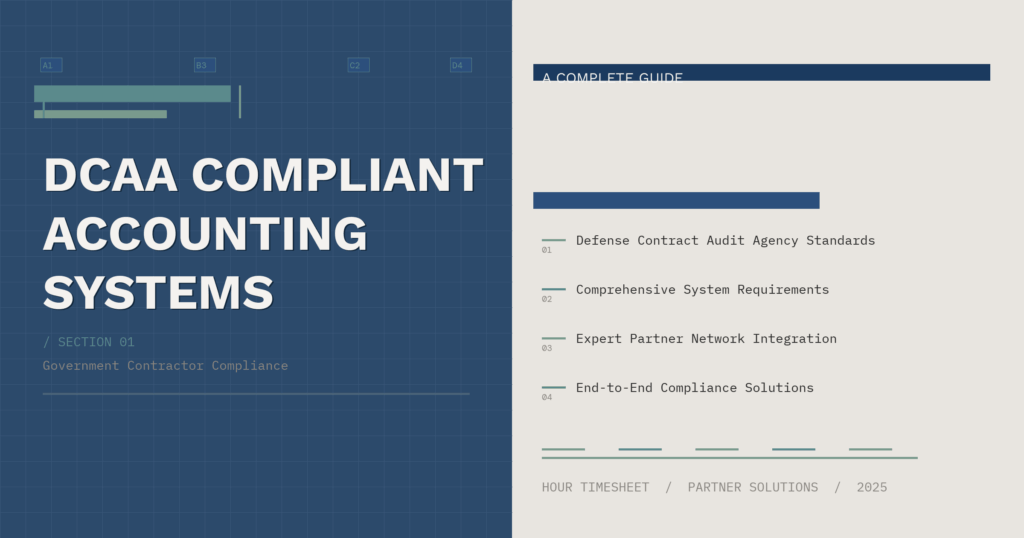
Your company modernized operations by implementing electronic timekeeping, eliminating paper timesheets and streamlining payroll processing. Employees swipe badges, managers approve time electronically, and your payroll integrates seamlessly with your accounting system. Then DCAA auditors questioned whether your electronic system actually meets government contract timekeeping requirements under FAR 31.201-4 and discovered your clock-in system tracks attendance but doesn’t capture the job costing detail, daily entry certification, or audit trail documentation proving labor charges to government contracts reflect actual work performed. Here’s what contractors miss about electronic timekeeping: modern technology provides efficiency and accuracy for payroll, but DCAA compliance requires specific capabilities proving time charged to government contracts is accurate, allowable, and properly allocated. Understanding how to configure electronic timekeeping for government compliance—or when to supplement attendance systems with purpose-built solutions—protects your contract portfolio while leveraging technology investments.
The Legal Framework Electronic Timekeeping Must Satisfy
DCAA timekeeping requirements stem from Federal Acquisition Regulation cost principles establishing that labor costs must be supported by adequate documentation. FAR 31.201-2 mandates reasonable costs, meaning labor charges must reflect actual time employees spent on contracts, not estimates, averages, or statistical distributions. FAR 52.232-7, the Payments under Time-and-Materials and Labor-Hour Contracts clause, creates specific requirements that contractors maintain and make available time records supporting labor charges—requirements enforced through DCAA audit procedures detailed in Contract Audit Manual Chapter 5.
The DCAA standard for timekeeping adequacy requires systems capturing six essential elements: daily time entry showing hours worked each day, charging to specific contracts or cost objectives reflecting actual work performed, employee certification attesting to time accuracy, supervisory approval confirming work performance, contemporaneous recording prohibiting after-the-fact reconstruction, and complete audit trails showing any corrections or changes. Electronic systems must deliver all six elements, not just convenient clock-in/clock-out functionality serving payroll needs.
Cost Accounting Standard 418, governing allocation of direct and indirect costs, reinforces timekeeping requirements by mandating that labor cost allocation must be based on actual causal relationships between work performed and contracts benefiting from that work. Your timekeeping system must capture information supporting cost allocation decisions—which means tracking work activities, not just attendance hours. When employees work on multiple contracts during a day, your system must record the specific distribution of time across those contracts, not apply allocation percentages after the fact.
What Contractors Must Understand About Electronic System Capabilities
Here’s what contractors miss about electronic timekeeping: badge swipe systems, biometric attendance tracking, and mobile clock-in apps excel at capturing when employees arrive and depart, but they rarely capture what work employees performed or which contracts benefited from their time. Your attendance system prevents time theft and ensures accurate payroll hours, but DCAA needs job costing information proving labor charges to government contracts reflect actual project work, not convenient cost allocation assumptions.
The daily time entry requirement creates the first major compliance gap in basic electronic systems. Many attendance platforms record weekly totals or allow batch time entry at week-end, violating DCAA’s mandate for daily contemporaneous recording. Understanding DCAA timekeeping requirements means implementing systems requiring employees to record time daily with system-enforced controls preventing submission delays. The requirement isn’t arbitrary—daily entry ensures accuracy by capturing information while fresh in employees’ minds, reducing errors from weekly reconstruction attempting to remember Monday’s activities on Friday afternoon.
Contract-level detail represents another critical capability gap. Your attendance system might track department, cost center, or general project codes serving internal cost accounting needs, but DCAA requires charging to specific government contracts with sufficient detail to support cost accumulation by contract line item, task order, or work package when your contracts require that granularity. Generic codes like “Government Work” or “Defense Projects” don’t satisfy compliance requirements when you’re performing multiple simultaneous contracts requiring separate cost tracking.
The certification and approval workflow separates compliant electronic systems from simple attendance tracking. DCAA requires employee certification—an affirmative statement that recorded time is accurate and represents actual work performed—plus supervisory approval confirming the employee actually performed the certified work. Electronic signatures satisfy these requirements when properly implemented with audit trails showing who certified, when certification occurred, and preserving original certified records. Badge swipes don’t constitute certification, and manager approval of payroll hours differs from supervisory certification of contract work performance.
DCAA compliance explained for electronic timekeeping means understanding these systems must deliver complete audit trails demonstrating compliance, not just efficient payroll processing.
Five Essential Steps for Electronic Timekeeping Compliance
Step 1: Implement Daily Time Entry with Mandatory Submission Controls
Configure your electronic timekeeping system requiring employees to record time daily with system-enforced submission deadlines preventing delayed entry. Deploy automated reminders notifying employees of unsubmitted timesheets before end of each workday, escalating to management alerts when employees approach deadline violations. Build system controls preventing payroll processing for employees with incomplete timesheet submissions, creating operational incentives ensuring compliance.
Design user interfaces making daily time entry simple and intuitive—compliance fails when systems create unnecessary complexity discouraging daily submission. Mobile-responsive platforms enabling employees to submit time from any device eliminate “I was away from my desk” excuses preventing daily entry. The goal is making daily compliance easier than delayed reconstruction.
Establish exception procedures for legitimate situations requiring retroactive time entry—travel, illness, system outages—with mandatory management approval and documented business justification for each exception. Track exception frequency by employee identifying individuals requiring additional training or supervision ensuring consistent daily entry compliance.
Step 2: Deploy Contract-Level Job Costing with Activity Detail
Build electronic timekeeping with hierarchical charging structures enabling employees to record time to specific contracts, then task orders or contract line items, then work activities or labor categories as your contracts require. Create dropdown menus or search functions helping employees quickly locate correct charge codes without memorizing complex numbering systems. Validate charge code availability preventing employees from charging to closed contracts or unauthorized accounts.
Implement favorite or frequently-used contract lists enabling employees to access their primary charge codes quickly while maintaining ability to search full contract listings for occasional charges. Balance ease of use with system controls ensuring proper cost accumulation supporting contract requirements and DCAA audit procedures.
Deploy activity code capabilities when your contracts require distinguishing between engineering, manufacturing, testing, or other work activities within single contracts. This detail supports earned value management, technical performance assessment, and cost allocation verification during audits demonstrating labor charges align with contract deliverables and technical progress.
Step 3: Create Electronic Certification and Approval Workflows
Implement electronic signature capabilities meeting legal standards for binding attestations including user authentication, tamper-evident record preservation, and audit trail maintenance showing certification dates and any subsequent modifications. Build certification language into timesheet submission workflows requiring employees to affirmatively acknowledge accuracy before system acceptance—passive submission without certification doesn’t satisfy DCAA requirements.
Deploy supervisory approval workflows routing submitted timesheets to appropriate managers based on organizational structure, project assignments, or contract requirements. Create approval dashboards showing managers pending timesheets requiring review with aging indicators highlighting items approaching deadline for timely approval. Build escalation procedures routing unprocessed approvals to higher management preventing approval bottlenecks delaying payroll or contract billing.
Establish periodic recertification requirements for previously approved timesheets when significant changes occur—contract modifications, rate adjustments, or error corrections—requiring fresh management review and approval confirming continued accuracy after modifications. Maintain complete audit trails showing original submissions, all modifications, and resulting approvals demonstrating system integrity.
Step 4: Establish Comprehensive Audit Trail and Change Documentation
Configure electronic systems maintaining complete transaction histories capturing original time entries, all modifications with date/time stamps, user identification for every action, and business justification for changes requiring approval. Build system architecture preventing unauthorized deletion or modification of historical records ensuring audit trail integrity for required retention periods extending minimum three years after final contract payment.
Implement change control procedures requiring documented justification for timesheet corrections with approval workflows scaled to correction significance—small clerical errors might require supervisor approval while material changes affecting contract charges require management review and documented business rationale. Create correction reports monitoring frequency and patterns identifying potential compliance issues or training needs.
Deploy automated backup systems ensuring audit trail data protection through redundant storage, disaster recovery procedures, and retrieval capabilities enabling DCAA auditors to access historical records efficiently without requiring manual reconstruction or supplemental documentation development.
Step 5: Build Integration Between Timekeeping and Job Costing Systems
Create seamless integration feeding approved timesheet data directly into project accounting and job costing systems without manual intervention, allocation formulas, or statistical distribution. When employees record 8 hours to Contract A, your job costing must charge exactly 8 hours of that employee’s labor rate to Contract A—zero tolerance for disconnects between timekeeping and cost accounting.
Implement reconciliation procedures comparing timesheet system totals to job costing labor accumulation by employee, project, and accounting period. Investigate any variances immediately requiring root cause analysis and corrective action before variances accumulate into systematic problems discovered during DCAA audits. Monthly reconciliation demonstrates system integration integrity while identifying interface failures requiring immediate correction.
Establish validation controls preventing cost accounting system acceptance of labor charges lacking proper timesheet support—no manual labor entries, no allocation percentages, no after-the-fact distributions circumventing timekeeping records. These controls enforce fundamental requirement that labor costs charged to government contracts must flow from approved timesheet documentation.
The Investment in Compliant Electronic Timekeeping
Implementing DCAA-compliant electronic timekeeping systems costs between $15,000 and $45,000 for small to mid-sized contractors depending on user count, integration requirements, and existing technology infrastructure. Purpose-built solutions like Hour Timesheet deliver required capabilities at price points accessible for small businesses while enterprise implementations requiring custom ERP integration may reach higher investment levels. Annual subscription costs typically range $3,000 to $12,000 based on user licensing and support services.
Let me show you the value: contractors with compliant electronic timekeeping systems process payroll more efficiently, reduce administrative burden on employees and managers, generate reliable job costing data supporting project management decisions, and demonstrate professionalism to DCAA auditors through systematic compliance rather than scrambling to reconstruct documentation during audits. Your timekeeping investment supports both operational efficiency and regulatory compliance—dual value justifying the expenditure.
Contractors with inadequate electronic systems face audit findings requiring costly manual timesheet reconstruction, questioned costs when labor charges can’t be supported by adequate documentation, and competitive disadvantages when accounting system deficiencies appear in past performance evaluations affecting source selection. The cost of inadequate timekeeping extends beyond immediate audit impacts to affect future contract opportunities through damaged reputation with government customers.
Understanding Timekeeping Requirements Across Federal Agencies
DCAA timekeeping standards apply uniformly across all federal agencies and contract types. Your electronic system must satisfy identical requirements whether supporting Department of Defense contracts, NASA programs, Department of Energy work, or civilian agency agreements. The six essential elements—daily entry, contract detail, certification, approval, contemporaneous recording, and audit trails—create national compliance standards eliminating agency-specific variations.
Fixed-price contracts require the same timekeeping rigor as cost-reimbursement contracts when fixed prices were established using cost or pricing data or when contract modifications require equitable adjustment calculations based on actual costs incurred. Time-and-materials contracts face enhanced scrutiny because labor hours directly drive contract payments. Your electronic timekeeping must serve all contract types in your portfolio through consistent compliance approach.
Your Path to Electronic Timekeeping Success
The electronic timekeeping landscape rewards contractors who implement purpose-built solutions designed specifically for government contractor compliance rather than adapting commercial attendance systems serving different business needs. DCAA auditors evaluate system capabilities against regulatory requirements, not technology sophistication—your $100,000 attendance platform receives identical scrutiny as contractors using $10,000 specialized government contractor systems.
For contractors seeking electronic timekeeping combining operational efficiency with DCAA compliance, Hour Timesheet provides purpose-built solutions delivering all six essential elements auditors require. Our platform enforces daily time entry, captures contract-level detail with activity tracking, implements certification and approval workflows, maintains comprehensive audit trails, and integrates seamlessly with major accounting systems feeding approved time directly into job costing.
Your timekeeping system represents the foundation of government contract cost accounting. Build that foundation on compliant technology serving both operational needs and regulatory requirements.
Additional Resources
Related Hour Timesheet Articles:
- DCAA Timekeeping Requirements
- DCAA Compliance Requirements for Contractors
- DCAA Compliance Explained
Official Regulatory References:



